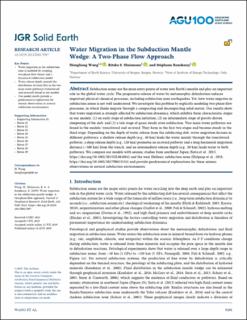| dc.contributor.author | Wang, Hongliang | |
| dc.contributor.author | Huismans, Ritske | |
| dc.contributor.author | Rondenay, Stéphane | |
| dc.date.accessioned | 2021-02-10T14:07:36Z | |
| dc.date.available | 2021-02-10T14:07:36Z | |
| dc.date.created | 2019-10-13T12:45:14Z | |
| dc.date.issued | 2019 | |
| dc.Published | Journal of Geophysical Research: Solid Earth. 2019, 124 (8), 9208-9225. | en_US |
| dc.identifier.issn | 2169-9313 | |
| dc.identifier.uri | https://hdl.handle.net/11250/2727246 | |
| dc.description.abstract | Subduction zones are the main entry points of water into Earth's mantle and play an important role in the global water cycle. The progressive release of water by metamorphic dehydration induces important physical‐chemical processes, including subduction zone earthquakes. Yet, how water migrates in subduction zones is not well understood. We investigate this problem by explicitly modeling two‐phase flow processes, in which fluids migrate through a compacting and decompacting solid matrix. Our results show that water migration is strongly affected by subduction dynamics, which exhibits three characteristic stages in our models: (1) an early stage of subduction initiation; (2) an intermediate stage of gravity‐driven steepening of the slab; and (3) a late stage of quasi steady state subduction. Two main water pathways are found in the models: trenchward and arcward. They form in the first two stages and become steady in the third stage. Depending on the depth of water release from the subducting slab, water migration focuses in different pathways: a shallow release depth (e.g., 40 km) leads the water mainly through the trenchward pathway, a deep release depth (e.g., 120 km) promotes an arcward pathway and a long horizontal migration distance (~300 km) from the trench, and an intermediate release depth (e.g., 80 km) leads water to both pathways. We compare our models with seismic studies from southeast Japan (Saita et al., 2015, https://doi.org/10.1002/2015GL063084) and the west Hellenic subduction zone (Halpaap et al., 2018, https://doi.org/10.1002/2017JB015154) and provide geodynamical explanations for these seismic observations in natural subduction environments. | en_US |
| dc.language.iso | eng | en_US |
| dc.publisher | Wiley | en_US |
| dc.rights | Attribution-NonCommercial-NoDerivatives 4.0 Internasjonal | * |
| dc.rights.uri | http://creativecommons.org/licenses/by-nc-nd/4.0/deed.no | * |
| dc.title | Water Migration in the Subduction Mantle Wedge: A Two-Phase Flow Approach | en_US |
| dc.type | Journal article | en_US |
| dc.type | Peer reviewed | en_US |
| dc.description.version | publishedVersion | en_US |
| dc.rights.holder | Copyright 2019. The Authors. | en_US |
| cristin.ispublished | true | |
| cristin.fulltext | original | |
| cristin.qualitycode | 2 | |
| dc.identifier.doi | 10.1029/2018JB017097 | |
| dc.identifier.cristin | 1736738 | |
| dc.source.journal | Journal of Geophysical Research (JGR): Solid Earth | en_US |
| dc.source.40 | 124 | en_US |
| dc.source.14 | 8 | en_US |
| dc.source.pagenumber | 9208-9225 | en_US |
| dc.relation.project | Norges forskningsråd: 231354 | en_US |

